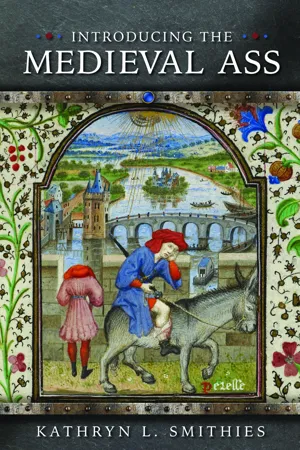![]()
ENDNOTES
INTRODUCTION
1. The domestic ass (Equus africanus asinus) that appeared in the medieval world was a descendant from two subspecies of wild ass originating in north Africa and the Near and Middle East: the Nubian and Somalian wild asses, respectively (Equus africanus africanus and Equus africanus somaliensis). Stine Rossel et al., ‘Domestication of the Donkey: Timing, Processes, and Indicators’, Proceedings of the National Academy of Sciences of the USA, 105/10 (2008), 3716.
2. Isidore of Seville, The Etymologies of Isidore of Seville, ed. and tr. Stephen A. Barney et al., with the collaboration of Muriel Hall (Cambridge: Cambridge University Press, 2006).
3. Isidore, Etymologies, p. 249.
4. John C. Coldewey, ‘Secrets of God’s Creatures: Talking Animals in Medieval Drama’, European Medieval Drama, 3 (2000), 74.
5. For the etymology of ‘donkey’ and ‘dun (adj.)’, see The Oxford English Dictionary Online (Oxford: Oxford University Press, 2000–), available at http://www.oed.com, accessed 15 August 2019.
6. Jill Mann (ed. and tr.), Ysengrimus (Leiden: Brill, 1987), pp. 334–7.
7. Mann, Ysengrimus, p. 337; Jean. R. Scheidegger, ‘Le Conflit des Langues: Ecriture et Fiction dans l’Ysengrimus’, Canadian Journal of Netherlandic Studies, 4/1 (1983), 9–17; L. G. Donovan, ‘Ysengrimus and the Early Roman de Renard’, Canadian Journal of Netherlandic Studies, 4/1 (1983), 33–8.
8. Mann, Ysengrimus, pp. 364–5.
9. Tony Fairman, ‘How the Ass became a Donkey’, English Today, 40/4 (1994), 29–35.
10. A. E. Housman, ‘The Latin for Ass’, The Classical Quarterly, 24/1 (1930), 11–13; for the etymology of si and anus see Charlton T. Lewis and Charles Short (eds), A Latin Dictionary (Oxford: Clarendon Press, 1879; repr. 1958), pp. 134, 1688–9.
11. The earliest evidence for ass domestication is witnessed in visual and archaeological sources. Juliet Clutton-Brock, Horse Power: A History of the Horse and Donkey in Human Societies (London: Natural History Museum Publications, 1992), p. 11; Caroline Grigson, ‘Size Matters: Donkeys and Horses in the Prehistory of the Southernmost Levant’, Paléorient, 38/1–2 (2012), 189.
12. Peter Mitchell, The Donkey in Human History: An Archaeological Perspective (Oxford; Oxford University Press, 2018), pp. 42–4.
13. For Zimri-Lim see Jack M. Sasson, ‘Thoughts of Zimri-Lim’, Biblical Archaeologist, 47/2 (1984), 118–19; for Damascus asses, see Clutton-Brock, Horse Power, p. 94; for ass-riding gods, see Laura Hobgood-Oster, Holy Dogs and Asses: Animals in the Christian Tradition (Urbana: University of Illinois Press, 2008), pp. 26–7.
THE NATURAL WORLD OF THE ASS
1. Understandably speculative, there is some thought that some societies considered humans riding equids composite beasts. Peter Costello, The Magic Zoo: The Natural History of Fabulous Animals (New York: St Martin’s Press, 1979), p. 60; Anthony Dent, Donkey: The Story of the Ass from East to West (London: Harrap and Co., 1972), p. 49.
2. Isidore of Seville, The Etymologies of Isidore of Seville, ed. and tr. Stephen A. Barney et al., with the collaboration of Muriel Hall (Cambridge: Cambridge University Press, 2006), p. 246.
3. Isidore, Etymologies, p. 11.
4. For the Latin see Isidore of Seville, Etymologiarum sive originum libri XX, annot. W. M. Lindsay, 2 vols (Oxford: Clarendon Press, 1962), ii, Book XII: i, 38; Isidore, Etymologies, p. 249.
5. In late Latin, sedere, when applied to animals, came to mean ‘to sit on a horse; to be mounted or ridden’. Charlton T. Lewis and Charles Short (eds), A Latin Dictionary (Oxford: Clarendon Press, 1879; repr. 1958), p. 1158.
6. Bede (De natura rerum, 703); Rabanus Maurus (De rerum naturis, 742–7); Lambert of Saint Omer (Liber Floridus, 1090–1120); Hugh of Fouilly (De avibus, 1132–52); Alexander Neckam (De naturis rerum, c. late twelfth century).
7. Pauline Aiken, ‘The Animal History of Albertus Magnus and Thomas of Cantimpré’, Speculum, 22/2 (1947), 205–25.
8. William Wallace, ‘Albertus Magnus on Suppositional Necessity in the Natural Sciences’, in James A. Weisheipel (ed.), Albertus Magnus and the Sciences: Commemorative Essays 1980 (Toronto: Pontifical Institute of Mediaeval Studies, 1980), p. 128.
9. Galen (ad 130–210) was a Greek physician who promoted the theory of Humorism. This held that four principal bodily fluids, known as humours (black and yellow bile, blood and phlegm) needed to be balanced for good health. Humorism influenced Western medicine for over 1,000 years.
10. For example, Jacob van Maerlant translated Thomas’s text into Dutch, as Der naturen bloeme (c.1250), and Konrad of Megenberg’s Das Buch der Natur (c.1350) was the first German-language natural history text.
11. This is often referred to as the donkey seat and it is still used today in certain parts of the world as the preferred means to ride an ass. Juliet Clutton-Brock, Animals as Domesticates: A World View through History (East Lansing: Michigan State University Press, 2012), p. 31.
12. Thomas Cantimpratensis, Liber de natura rerum (New York: Walter de Gruyter, 1973), p. 109; the ass’s dorsal cross is a vestige of earlier striped ass species that can be traced back to the zebra on the equid cladogram. Dent, East to West, p. 19.
13. All quotes from and references to the Bible in English are from the critical scholarly edition of the King James Version (KJV), available at https://www.academic-bible.com, accessed 15 August 2019.
14. ‘En effet le bestiaire n’est pas pour fonction première d’observer les animaux en eux-mêmes: les animaux y sont un point de départ, ou plutôt un prétexte, pour permettre à l’homme de se connaître.’ Bruno Roy, ‘La Belle e(s)t la Bête: Aspects du Bestiaire Féminin au Moyen Age’, Etudes Françaises, 10/3 (1974), 319–20.
15. For a thorough and convincing discussion of the Physiologus’s date of production, see Alan Scott, ‘The Date of the Physiologus’, Vigiliae Christianae, 52/4 (1998), 430–41.
16. Jonathan Morton, ‘The Book of the World at an Anglo-Norman Court: The Bestiaire de Philippe de Thaon as a Theological Performance’, in Laura Ashe, Wendy Scase and David Lawton (eds), New Medieval Literatures, 16 (Woodbridge: Boydell and Brewer, 2016), p. 5; P. T. Eden (ed. and tr.), Theobaldi ‘Physiologus’ (Leiden: Brill, 1972), pp. 2–3.
17. Willene B. Clark, A Medieval B...
